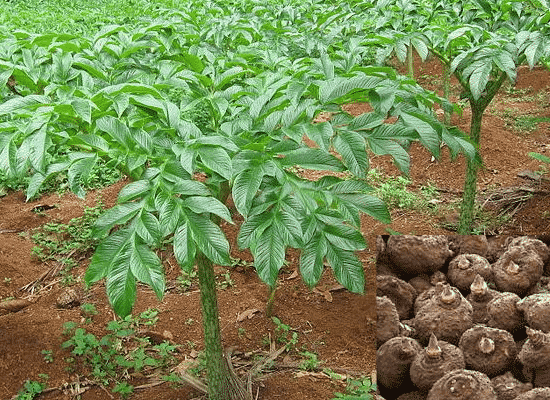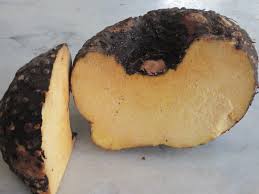Elephant Foot Yam Cultivation:

Introduction of Elephant Foot Yam: – It is one of the most profitable tuber crops cultivated in India. These tubers are consumed as vegetables after thorough cooking and chips are made out of these starch-rich tubers. Tender stems and yam leaves are also consumed as vegetables. This elephant yam mainly cultivated in India, south East Asia, Philippines and Sri Lanka. The Elephant foot yam belongs to the family of “Araceae” and Genus of “Amorphophallus”.
Advantages of Elephant Foot Yam Cultivation:- The following are the advantages of elephant foot yam cultivation.
- Elephant yam has good shade tolerance
- Easiness in cultivating this tuber crop
- High productivity of yams
- Elephant yam crop has less incidence of pests & diseases
- Elephant yam has steady market price.
Health benefits of Elephant Foot Yam:- There are tones of health benefits with elephant foot yam.
- Elephant foot yam is a good source of protein and carbohydrates and omega 3 fatty acids.
- Elephant foot yam helps in reducing LDL (bad cholesterol)
- Elephant foot yam helps in asthma and bronchitis patients
- Elephant foot yam helps in lowering blood sugar levels
- Elephant foot yam helps in controlling the abdominal pain
- Elephant foot yam helps in preventing muscle spasms
- Elephant foot yam helps in reducing the risk of cancer
- Elephant foot yam helps in weight Loss
- Elephant foot yam helps in women for estrogen and hormonal balance
- Elephant foot yam helps in lowering the blood pressure
- Elephant foot yam is a source of antioxidants
- Elephant foot yam helps in liver cleansing
- Elephant foot yam has low glycemic index, hence helps in diabetic patients.

Elephant Foot Yam high Production States in India:- Bihar, West Bengal, Karnataka, Kerala, Maharashtra, Odhisa, Andhra Pradesh and Telangana.
Elephant Foot Yam Local Names in India:- Suran, Zamikand (Hindi), Suran (Marathi), Oal (Bengali), Kanda Gadda (Telugu),Senai Kizhangu (Tamil), Suvarna Gedde (kannada), Chena (Malayalam), Oluo (Oriyya).
Varieties of Elephant Foot Yam in India:- Sree Padma and Gagendra are most popular improved varieties.
Climate Requirement for Elephant Foot Yam Cultivation:- Basically, elephant yam is a subtropical and tropical crop which requires humid and warm climatic conditions for its vegetative growth and cool and dry climate for its corm development. A Well distributed annual rain fall will result in good productivity.
Soil Requirement for Elephant Foot Yam Cultivation:- Elephant foot yam grows well in fertile red-loamy and well-drained soil. The soil pH range of 5.5 to 7.2 is preferred for its cultivation.
Propagation in Elephant Foot Yam Cultivation:- This crop is propagated through “corm”.
Land Preparation, Spacing and Planting in Elephant Foot Yam Cultivation:- Bring the soil to fine tilth and form beds after giving 1 or 2 ploughings. Pits size of 60 cm x 60 cm x 45 cm should be dug at a distance of 90 cm x 90 cm during Feb month. For small to medium sized tubers, spacing between pits can be reduced to 60 cm x 60 cm. Make sure to fill the pits with half top soil, well-decomposed farm yard manure (FMY) at the rate of 2 to 3 kg/pit and wood ash.
Corms harvested in November should be stored in well ventilated place. Before planting the corms in the main field, they should be cut into sets of 750 to 1000 grams, each bearing a portion of central bud. These cut corms should be smeared with cow dung slurry or wood ash and allowed to dry in partial shade. Mini sett transplants of 100 grams size should be planted at a distance of 45 cm x 30 cm. planting material should be placed vertically in the pit. After packing the pits with top soil and other manures, they should be mulched with paddy straw or green leaves for moisture conservation and weed control.
Intercropping in Elephant Foot Yam Cultivation:- Cow pea vegetable is best suited inter-crop in elephant foot yam Cultivation. Elephant yam can also be inter-cropped in banana, coffee, arecanut, rubber and coconut plantations due its shade tolerance property. If you are planning for elephant yam as intercrop in above mentioned plantations, half quantity (12 tonnes/ha) of farm yard manure and 1/3rd of N:P:K (27:20:34 kg/ha) in well enough for the intercrop. spacing of 90 cm x 90 cm should be maintained, if you are planning elephant yam as intercrop in other main plantation.
Irrigation in Elephant Foot Yam Cultivation:- Generally, elephant foot yam is cultivated under rainfed conditions. However, in case of dry season or under commercial cultivation, this crop requires irrigation. Irrigation should be given once a week depending on the climate and soil moisture holding capacity. In case of heavy rains and floods, make sure to drain out the water from the soil as soon as possible as water logging in the crop damages the crop and causes diseases.
Weed Control in Elephant Foot Yam Cultivation:- Weeding and earthing up should be carried as and when necessary. Mulching will check the weed growth around the pits.
Manures and Fertilizers in Elephant Foot Yam Cultivation:- Supplement the land with well rotten dry farm yard manures (FMY) of 25 to 30 tonnes per hectare during the last ploughing. Fertilizers of NPK should be applied in the ratio of 80:60:100 kg/ha in two doses. The NPK dose of 0:60:50 kg/ha should be applied after 45 days of planting along with intercultural operations. Top dress with N: K in the ratio of 40:50 after a month later along with shallow intercultural tasks.
Pests and Diseases in Elephant Foot Yam Cultivation:- Leaf spot and Collar rot are main diseases in elephant foot yam plants.
- Leaf spot=> Can be controlled by spraying Mancozeb at 2 g/lit.
- Collar rot=> This disease is mainly caused by soil borne fungus and controlled by drenching the soil with carbenilazim or apply biocontrol agents like Trichoderma harzianumI @ 2.5 kg/ha mixed with 50 kg of farm yard manure (FYM). Remove infected plants and apply neem cake. Prevent any water stagnation conditions in the field.
Harvesting in Elephant Foot Yam Cultivation:- This crop will be ready for harvesting in 7 to 9 months after planting. One can easily identify the harvesting time when plant stems and leaves dry and starts falling. For better market price, start harvesting from 6 months onwards. Use pick axe or dig the soil for harvesting the tubers.
Yield in Elephant Foot Yam Cultivation:- Yield depends on the variety grown and farm management practices. In Elephant Foot Yam Cultivation, yield of 30-40 t/ha can be expected in 8 months period.
For Sheep and Goat Farming Information: Read Here.
Where to get elephant yam seeds
If you are from Odisha then you can collect from Center Tuber Crop Research Institute ( CTCRI ),Bhubaneswar.
how to get a moisture certificate for elephant yam export